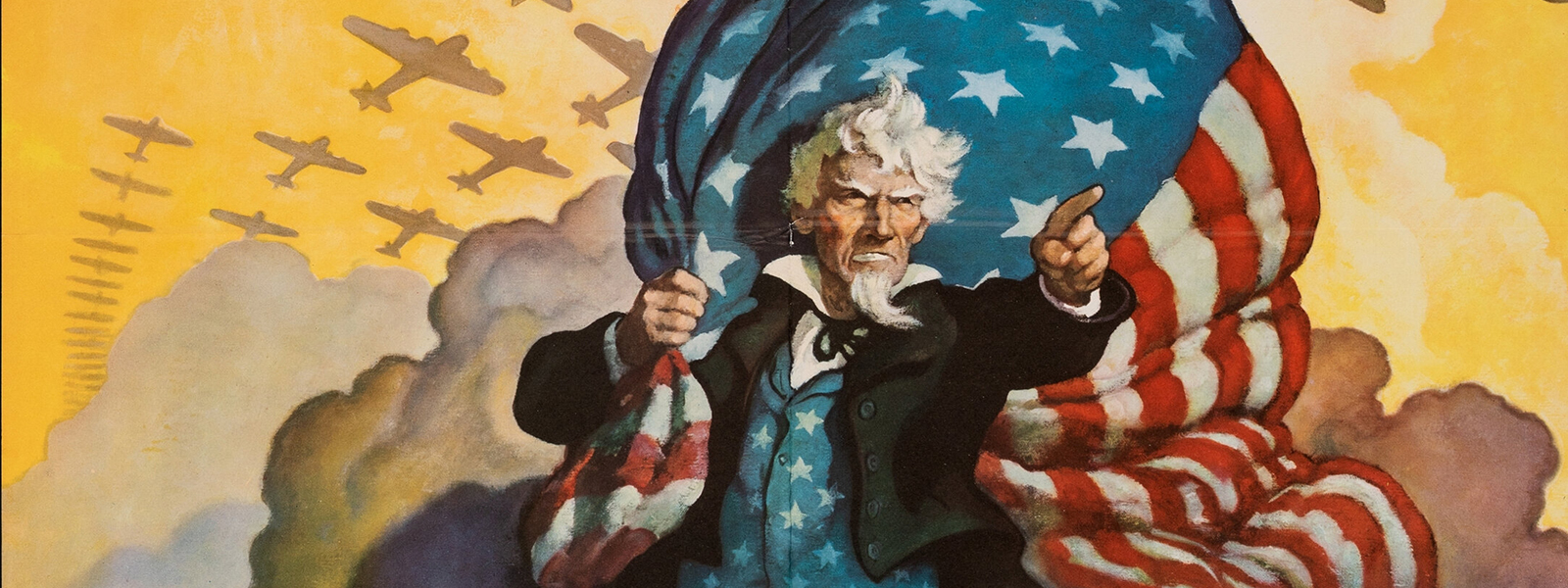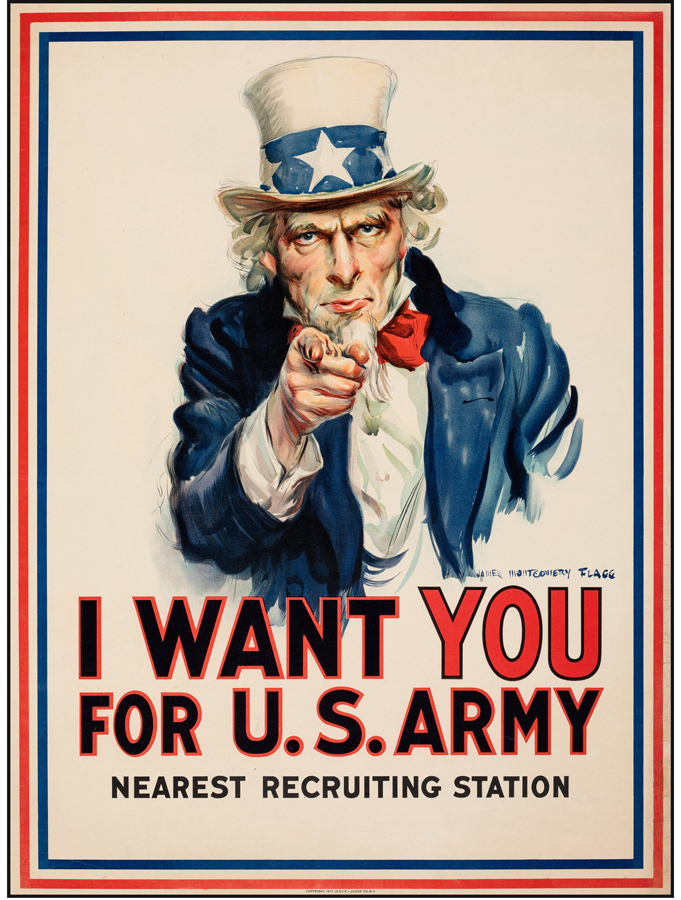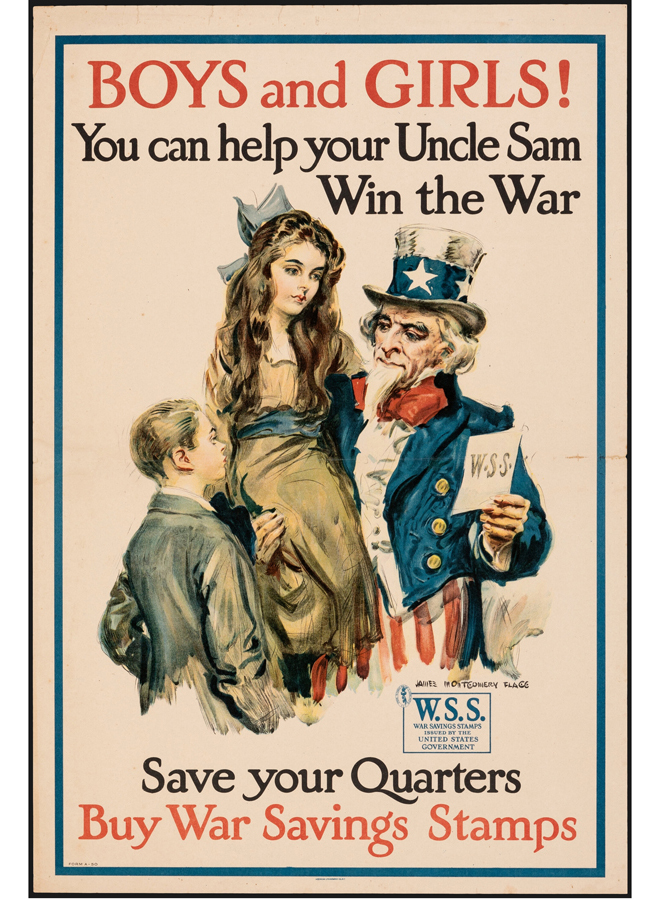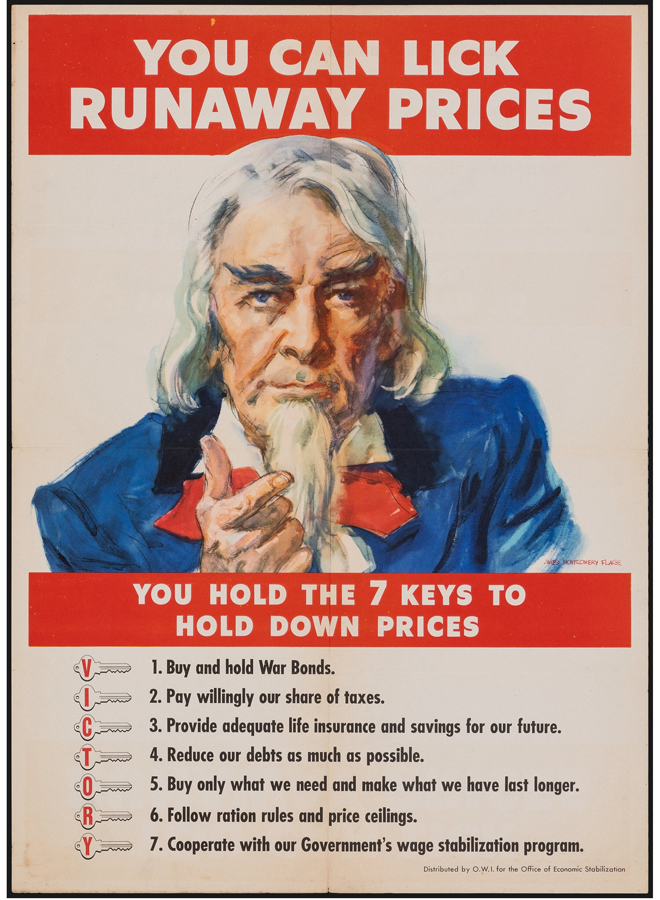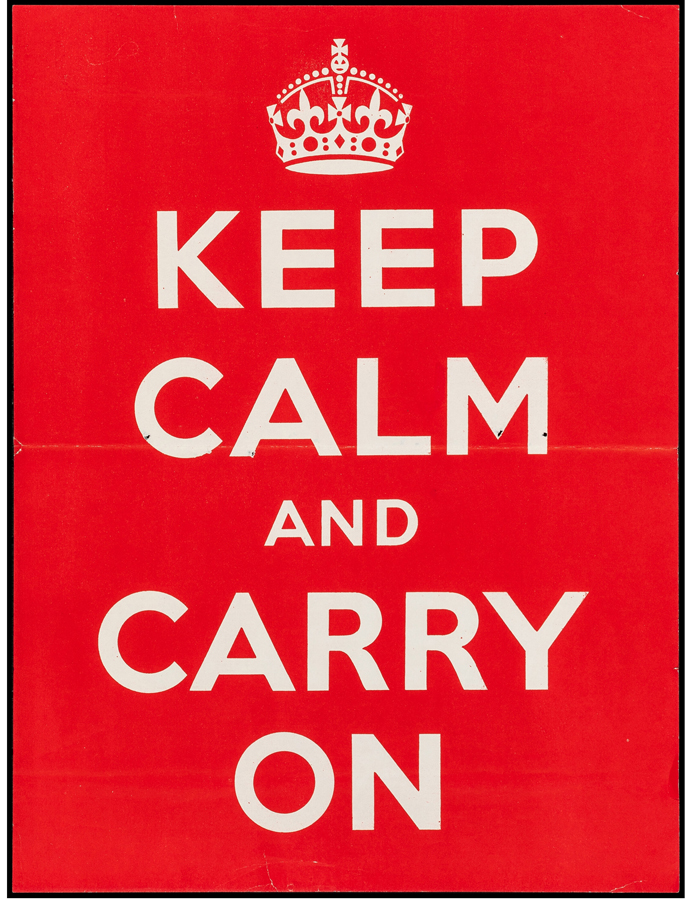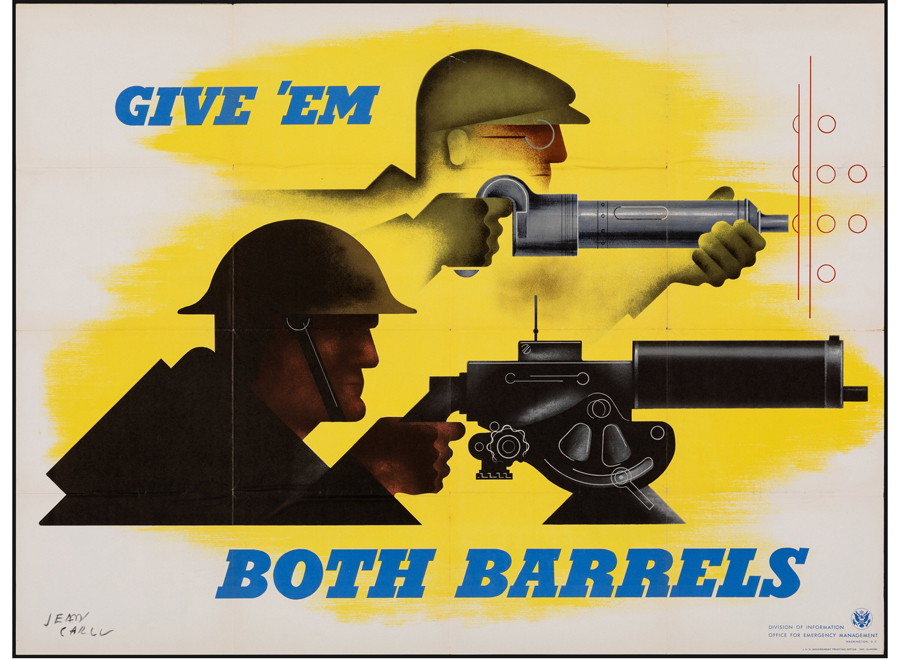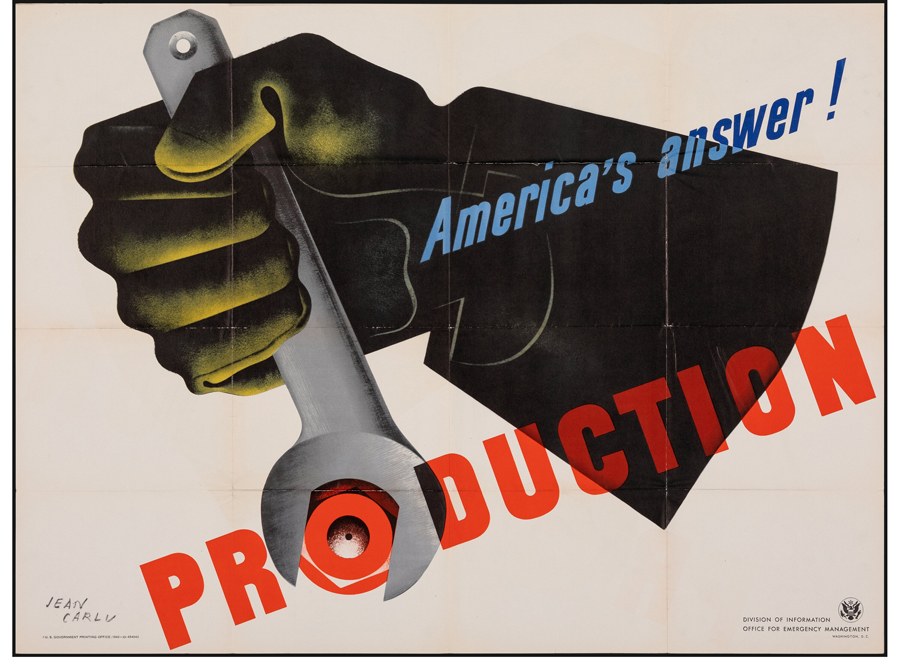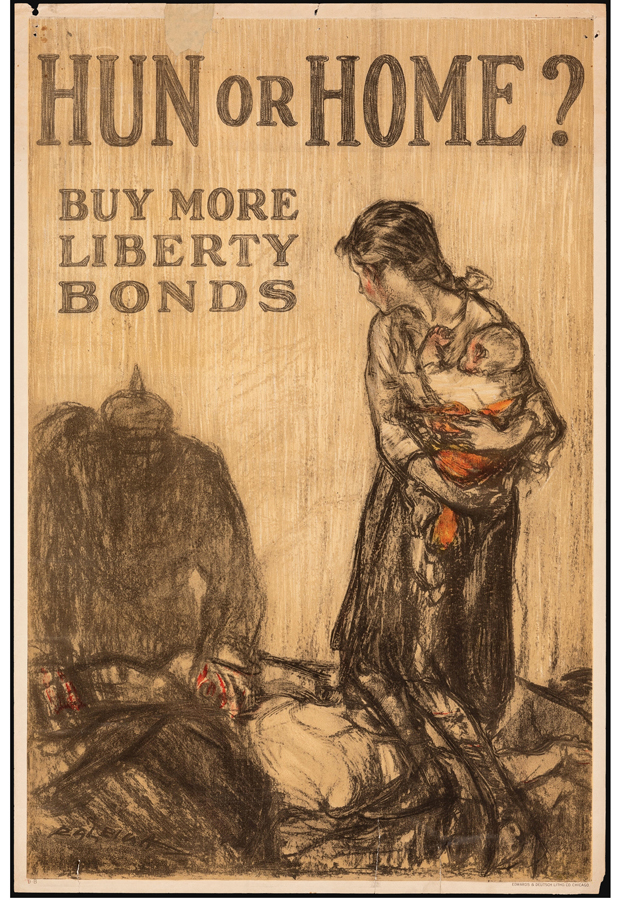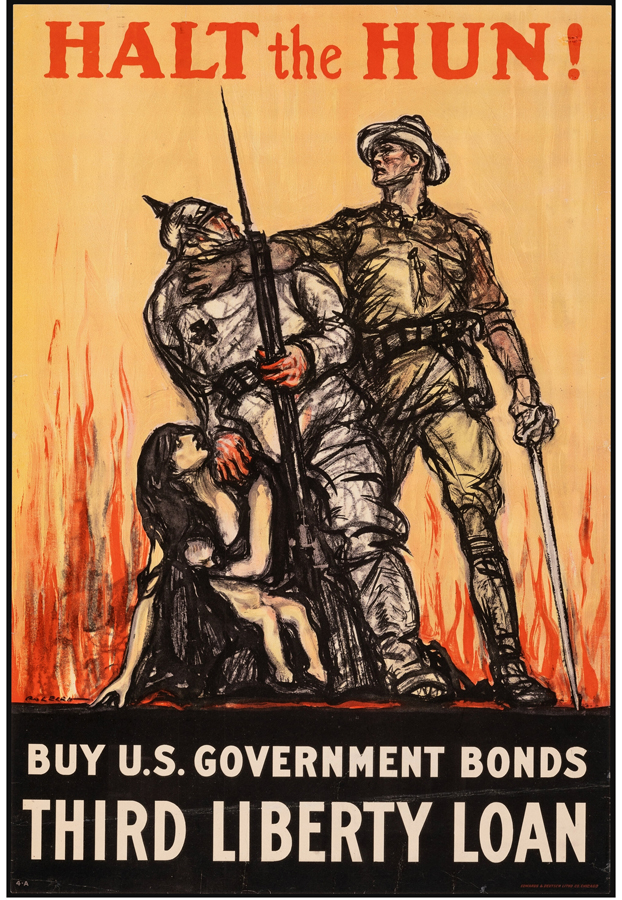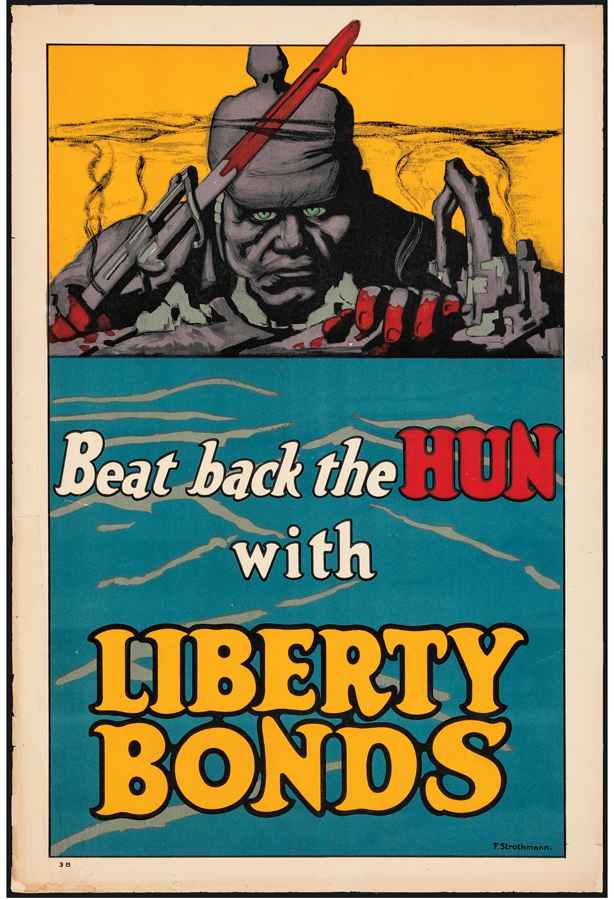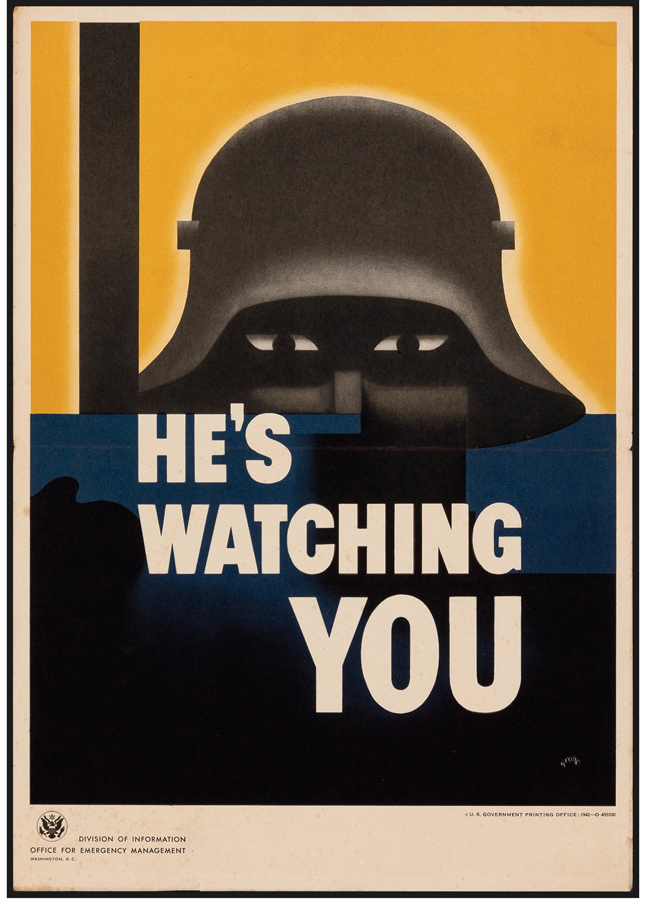FROM AMERICA’S UNCLE SAM TO BRITAIN’S ‘KEEP CALM AND CARRY ON,’ THESE WARTIME PROPAGANDA POSTERS WERE DESIGNED TO ENCOURAGE, RECRUIT, COMFORT AND TERRIFY
By Andrew Nodell
To quote John Stuart Mill, “War is an ugly thing.” Far worse in the eyes of the 19th-century English philosopher and politician would be the “decayed and degraded state of moral and patriotic feeling which thinks that nothing is worth a war.” While there is no denying the atrocities of war, we have reminders of their fight to preserve democracy and human rights in the form of posters and propaganda, examples of which can be viewed through a lens of ironic beauty to the modern eye. On June 6, which is also the 80th anniversary of D-Day, Heritage presents The Art of War: Historical & Political Posters Showcase Auction. The carefully curated sale showcases examples of illustrations and graphic designs intended to boost morale, galvanize enlistment, and comfort (or sometimes intimidate) both the armed services and the homefront.
Some are instantly recognizable, like the auction’s iconic “Keep Calm and Carry On” poster, which has taken on pop-art status in the 21st century despite having limited distribution during World War II, while others are flatly racist by current standards, employing pejorative language toward the Japanese and Germans. But all of the examples stand as a historical record of a time, we hope, that will never be repeated. Here we explore highlights from the auction and the artists who did their part in the war effort throughout the past century.
James Montgomery Flagg’s World War I recruiting poster features a star-spangled Uncle Sam and one iconic phrase: ‘I Want You for U.S. Army.’
James Montgomery Flagg (1877-1960)
Inspired by a 1914 wartime poster by graphic artist Alfred Leete depicting Lord Kitchener, the British Secretary of State for War, American illustrator James Montgomery Flagg’s archetypal “I Want You” poster of Uncle Sam has reached mythical status. Created in 1917, the same year the U.S. officially entered the Great War, the poster depicts the patriotic character modeled after Flagg’s own likeness. Uncle Sam appeared on other posters that year including “Boys and Girls! You Can Help Your Uncle Sam Win the War,” which encouraged children during World War I to buy war savings stamps. Once a child’s stamp book was filled, it could be exchanged for a $5 War Savings Certificate Stamp that was similar to liberty loan war bonds and paid interest, motivating American citizens of all ages to join the war effort.
During World War I, children supported the United States by buying war savings stamps, and this circa 1917 poster encouraged their involvement.
Flagg’s first Uncle Sam sternly encouraged young men to enlist in the armed forces. This version reminds those at home to do their part to fight inflation.
Beyond his illustrations, Flagg was known for his portraits of notable contemporaries including author Mark Twain, boxer Jack Dempsey and actress Ethel Barrymore. Flagg revived the rugged Uncle Sam character in posters during the Second World War as seen in “Jap…You’re Next!” Strikingly racist to a modern viewer, this anti-Japanese propaganda encouraged Americans to support the post-Pearl Harbor war effort by purchasing bonds. Produced in 1943, Flagg’s “You Can Lick Runaway Prices” offers a somewhat softer version of Uncle Sam, who outlines seven steps to help keep inflation at bay during the war.
This 1939 ‘Keep Calm and Carry On’ poster is a piece of history turned pop culture craze.
“Keep Calm and Carry On” (United Kingdom Ministry of Information, 1939)
What has become a modern-day pop culture icon was almost lost to history. Printed by the United Kingdom’s Ministry of Information on the brink of WWII, “Keep Calm and Carry On” has been parodied and duplicated on everything from T-shirts to tea towels, but what many don’t realize is that this campaign was viewed as patronizing and insulting by the British public of the time. Although roughly 2.5 million “Keep Calm” posters were printed, few were displayed at the time and nearly all of them were pulped down for reuse. The message was meant to boost morale at a time when the threat of a Nazi air attack on the U.K. seemed imminent. It wasn’t until 2000 when a copy appeared at a used bookstore in Alnwick, a town in the north of England, that the “Keep Calm” craze took off and spurred collectors to seek out other rare originals.
French artist Jean Carlu created a series of posters for the United States government, including these two early-1940s examples: ‘Give ’Em Both Barrels’ and ‘America’s Answer! Production.’
Jean Carlu (1900-1997)
Jean Carlu was born to a family of French architects (his brother, Jacques, designed the Palais de Chaillot in Paris), but it was graphic design that appealed to the younger Carlu brother, who was attracted to Cubism and Art Deco styles of the early 20th century, as seen in these 1940s graphics. During WWII, Carlu created a series of posters for the U.S. government to promote the production of war materials and boost morale of civilian factory workers, highlighting the vital link between war efforts on the battlefield and homefront. “Give ’Em Both Barrels” from 1941, which portrays a laborer wielding a rivet gun beside a soldier with a machine gun, and “America’s Answer! Production” from 1942 illustrate the significant contributions made by American citizens at home.
German soldiers make menacing figures in these two propaganda posters featuring artwork by Henry Raleigh: ‘Hun or Home?’ and ‘Halt the Hun,’ both from 1918.
Henry Raleigh (1880-1944)
Born into an impoverished broken home in Oregon, Henry Raleigh amassed a fortune during the Golden Age of Illustration, complete with a mansion, yacht and well-heeled friends including F. Scott Fitzgerald. But as times changed and the public began consuming media through photography and moving pictures, Raleigh’s star faded and his spendthrift tendencies led him to financial ruin and an untimely death at a low-rent hotel in Times Square. Despite this, his haunting 1918 wartime illustrations are a vast departure from the high-society scenes he depicted for publications like The Saturday Evening Post and stand as a historic record of this perilous time. In “Halt the Hun,” we see an American soldier defending a frightened mother and child against his German counterpart. Raleigh’s bold pastel strokes lend to the image’s ominous tone. Similarly threatening, “Hun or Home?” depicts the lurking figure of a German soldier – identifiable by his spiked helmet, known as a pickelhaube – approaching a vulnerable woman and infant. Both posters encouraged the purchase of liberty bonds to help fund the war effort overseas. The tactic worked extremely well, with Americans buying more than $23 billion worth of bonds by the war’s end.
This 1918 Frederick Strothmann poster aimed to scare American citizens into purchasing war bonds.
Frederick Strothmann (1872-1958)
A native New Yorker, Frederick Strothmann’s illustrations appeared in some of the nation’s top publications at the time, including The Saturday Evening Post, Collier’s, Life, and Harper’s Magazine. His work also appeared in books by popular authors such as Mark Twain, but his WWI posters took on a decidedly darker tone. Printed by the U.S. government in 1918, “Beat Back the Hun With Liberty Bonds” presents a threatening anti-German visual message similar to those produced by contemporary Henry Raleigh. This poster shows a massive German soldier with bloody hands looming eerily over a war-torn landscape poised above the phrase “Beat Back the HUN with LIBERTY BONDS.” “Hun” was a commonly used derogatory term for German soldiers during the First World War and is derived from the nomadic Central Asian tribe that violently invaded parts of Europe between the 4th and 6th centuries. Strothmann’s striking visual aimed to evoke fear and depict German soldiers as soulless and savage, a common motif of WWI-era propaganda.
The ‘happy and satisfied’ soldier in this 1915 recruitment poster urged British men to ‘enlist to-day.’
“He’s Happy and Satisfied – Are You?” (Parliamentary Recruiting Committee, 1915)
Printed by Turner and Dunnett of London and Liverpool, this 1915 British poster depicts a peaceful soldier smiling contentedly in an effort to boost enlistment. The image stands in stark contrast to the forbidding and violent images that would come as WWI wore on and many of these “happy and satisfied” soldiers lost their lives, including brothers William and Fred Turner, sons of the printing firm’s senior partner, who each met their fate on the Continent the same year this poster was published and distributed.
Glenn Grohe’s 1942 depiction of a German soldier missed its mark with messaging, but it helped spur the creation of the U.S. Office of War Information.
Glenn Grohe (1912-1956)
Chicago-born painter and illustrator Glenn Grohe’s work graced the covers of magazines and was featured in commercial product advertisements. His 1942 propaganda poster, “He’s Watching You,” was meant to encourage wartime secrecy as a matter of national security but unfortunately missed the mark when it was released. The image shows a threatening German soldier, but the general public misinterpreted the Third Reich helmet as the Liberty Bell, while a number of factory workers surveyed by the U.S. government saw the bold design as a representation of their demanding bosses. This misstep helped usher in the creation of the U.S. Office of War Information, which reviewed and approved designs before being released so that future messages were not lost in translation.
Go here to see all the lots in Heritage’s June 6 The Art of War: Historical & Political Posters Showcase Auction. For inquiries, contact Zach Pogemiller at ZachP@HA.com or 214.409.1184.
 ANDREW NODELL is a contributor to Intelligent Collector.
ANDREW NODELL is a contributor to Intelligent Collector.

